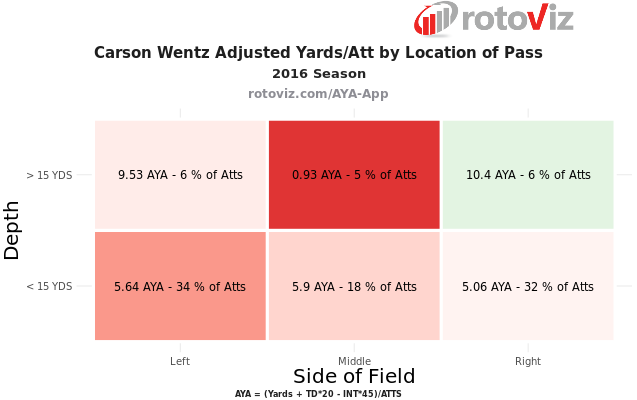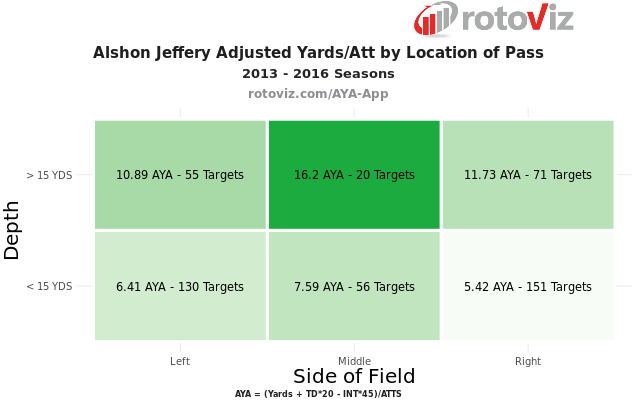Alshon Jeffery Can Help the Eagles' Offense Take Flight

For Philadelphia Eagles fans, Thursday ran the entire gamut of emotions.
First, there was the Torrey Smith signing that made it seem as if executive vice president of football operations Howie Roseman was grasping at straws after seeing Brandon Marshall, Kenny Britt, Pierre Garcon, and Kenny Stills sign elsewhere.
Torrey Smith, 3-year deal for $15mil with the Eagles, per source.
— Adam Schefter (@AdamSchefter) March 9, 2017
Smith seemed like an obscure consolation prize for Eagles fans. It was like winning *NSYNC's Home for Christmas CD at a charity event's raffle. Sure, CD's are rather obsolete now, but it's still *NSYNC, and you're definitely listening to "Merry Christmas, Happy Holidays" on the drive home despite it being March.
Then, when the "legal tampering" period was finally lifted at 4 p.m. EST, the skies parted, and a ray of sunlight beamed directly on my cell phone as I opened Twitter.
Alshon Jeffery to the Eagles for 1 year — $14M
— Ian Rapoport (@RapSheet) March 9, 2017
The Eagles signed Alshon Jeffery.
Suddenly loaded with an offense that has first- and second-round picks at every skill position, the Eagles can enter the draft with one fewer position to address.
What does Jeffery bring to the table?
Alshon the Wide Receiver
While injuries and a suspension may have plagued his last two seasons, is Jeffery still a top receiver when able to suit up?
Unfortunately, his numbers -- including his Net Expected Points (NEP) metrics -- are trending in the wrong direction.
| Year | Targets | Rec | Rec Yds | Rec TDs | Target NEP | Rec NEP | PPR Finish |
|---|---|---|---|---|---|---|---|
| 2013 | 148 | 89 | 1421 | 7 | 7th | 8th | WR8 |
| 2014 | 145 | 85 | 1133 | 10 | 17th | 11th | WR10 |
| 2015 | 94 | 54 | 807 | 4 | 41st | 31st | WR42 |
| 2016 | 94 | 52 | 821 | 2 | 73rd | 42nd | WR55 |
Jeffery's raw stats have declined, as have his cumulative production numbers in the past four years.
Granted, end-of-season stats are just one piece of the puzzle and shouldn't be taken without context. Jeffery missed seven games due to injury in 2015 and four games in 2016 due to suspension.
In 2016, Jeffery ranked ninth in expected points added per catch among the 68 receivers with at least 75 targets. He was 19th in Reception NEP per target, outperforming the Chicago Bears' other high-volume receiver, Cameron Meredith. Meredith ranked 51st of 68 in Reception NEP per catch and 38th on a per-target basis.
While he undoubtedly had a disappointing season last year, Jeffery outperformed his teammates and was quite the target hog from 2013 to 2015. He accrued a 26.3 percent target market share, averaging 9.5 targets per game during that time span.
He had the ninth-most 100-yard games (12). He had the highest number of targets per route run (0.33). He finished with 13 top-12 PPR weeks over those 41 games (31.7 percent).
Considering he played 2013 and 2014 as second fiddle to Brandon Marshall, we have yet to see what a fully healthy Alshon can do as the alpha receiver over the course of a full 16-game season.
And therein lies the problem.
Cliché for a reason, the biggest ability in the NFL is availability. It's a large reason why Alshon opted to sign a one-year deal in order to prove he was worth a big contract.
While he's fared quite well at times during the course of his career, he's missed 11 of his last 32 games. While there were reportedly other long-term deals on the table, Jeffery decided to forego those offers and bet on himself in 2017 in hopes of a better payday come next season.
Alshon the Philadelphia Eagle
Philadelphia may not have been his top option, but Jeffery has a great chance to succeed immediately in an offense that desperately needed a playmaker at wideout.
Last year, Carson Wentz ranked 20th among all quarterbacks in air yards. His 3.3 air yards per attempt were 31st in the league. While Wentz experienced some degree of success as a rookie, a lot of it was due to horizontal passing and some mediocre yards after catch -- not downfield attempts.
The additions of both Smith and Jeffery on the outside could bring a massive change to Doug Pederson's offense.
Since entering the league in 2011, only DeSean Jackson has a higher yards per reception mark than Smith's 17.0 career average. That's a vertical element the Eagles desperately need. Philadelphia ranked 29th in the league with just 39 receptions of 20-plus yards last season.
With Smith opening up the deep part of the field, Jeffery has a chance to truly do some damage all over the field. Both players add some much needed versatility to an offense that saw Wentz rarely succeed when passing beyond 15 yards.

Jeffery's ability to make plays all over the field at varying depths will be a welcome addition to the Eagles' offense.

There's some quality overlap between where Wentz has struggled and Alshon thrived.
The Eagles' offense in 2016 was voluminous, with Wentz ranking fifth in the league with 607 drop backs. Wentz is now suddenly inundated with receiving options of Jeffery, Smith, Jordan Matthews, Zach Ertz, and Darren Sproles, as the Eagles turned an offseason weakness into a strength.
While we may not see Jeffery receiving quite the same type of market share of targets as he saw in Chicago, he should still receive the lion's share. Dating back to his days in Kansas City, Pederson's top receiver garnered just 20.9 percent of the team's targets per NFL.com's Alex Gelhar.
That would leave Alshon right around the 125-target mark area if we project Wentz for a similar volume of attempts in 2017. That target total would've finished 20th among all wide receivers last year, and there's certainly room for him to eclipse that threshold as the clear alpha of this group.
Heading into the 2017 season, Jeffery has a chance to revitalize his career and public perception as a dominant wide receiver in the NFL. If he can avoid the injury bug and keep his head on straight, he has a chance for a massive payday this time next year.
















